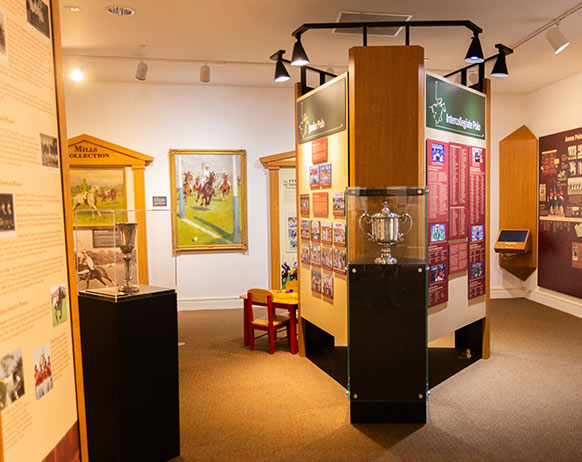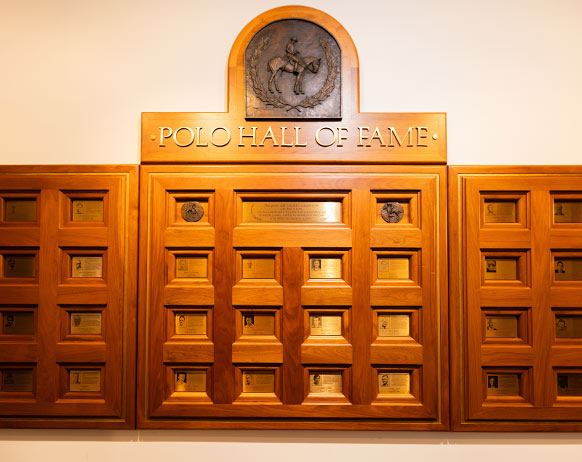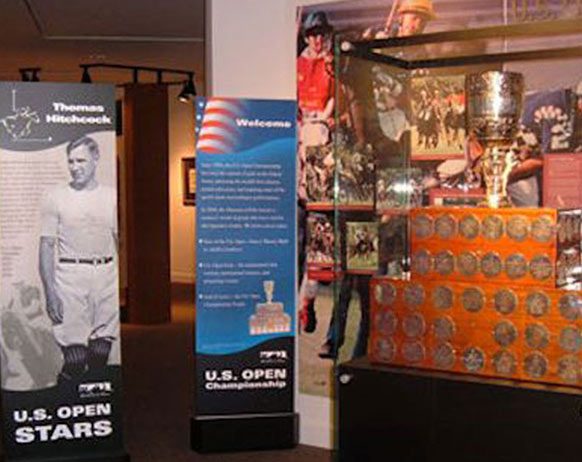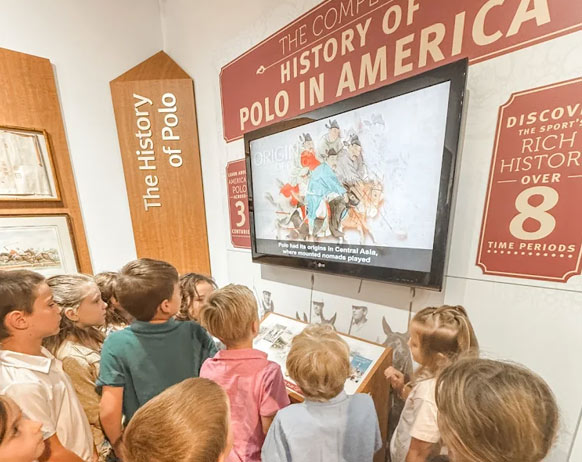Museum of Polo and Hall of Fame
Frequently Asked Questions
Here are the most commonly asked questions about polo, and some simple answers to familiarize you with the sport.
Originally, no horse higher than thirteen hands and two inches (54″) was allowed to play in the game of polo, so the horses were of “pony” size. Today there is no size limit and the horses used range from 14 to 16+ hands. Most polo horses are between 5 and 15 years of age, and are thoroughbreds, or crossbreeds of thoroughbreds and quarter horses.
The ideal polo pony combines speed, agility, courage, temperament and intelligence, and players acknowledge that a good pony contributes 50-80% of the pony/rider team’s ability. This is why you will see “Best Playing Pony” honors being awarded after important games and tournaments.
The polo field is 300 yards by 160 yards (about the area of nine football fields). The goal posts are set eight yards apart.
Sideboards help to keep the ball in play. Standing no more than 11 inches high and made of wood, sideboards are generally painted red or green.
When the ball crosses the line between the goal posts, it is a goal, regardless of who knocked it through (including the horse). In order to even out the affects of wind and turf conditions, teams switch goals (ends of the field) after each point is scored.
Four per team outdoors, three indoors (where four would be a crowd).
There are six periods, called “chukkers,” in a polo game (four in Indoor/Arena Polo), each lasting 7 minutes. At the end of the 6 1/2 minutes, a bell sounds to let the players know 30 seconds remain. At 7 minutes, a horn sounds to end the period.
In the event of a tie at the end of the final chukker, there is a 5-minute intermission to allow the players to catch their breath and change to a fresh mount before beginning a chukker in which the first team to score wins the match.
Players are rated on a scale of -1 to 10, determined by a player’s horsemanship, hitting, quality of horses, team play, game sense, and sportsmanship. The team handicap is the sum of its players’ handicaps. In handicap matches, the team with the higher handicap gives the difference in goals to the other team. For example, a 6-goal team will give two goals to a 4-goal team.
Number 1 is a forward, and attacking offensive player similar to a wing in hockey or a forward in soccer. Number 1 is also expected to “ride-off” the opposing defensive player allowing a trailing teammate the opportunity to score, similar to a blocking back in football.
Number 2 is also an offensive player, expected to be able to turn quickly and follow the lead of the Number 1 in order to be in position to pick up a pass or pick up a missed or blocked shot. His or her defensive responsibility is the opposing Number 3.
Number 3 is the field general. He or she attacks the opposing offense and turns the ball upfield, usually with a pass ahead to Number 1 or Number 2. The Number 3 must be able to hit long with accuracy. The Number 3 also aids in defense, taking the opposing Number 2 or offering defensive support to his or her Number 4.
Number 4 (also called the “Back”) defends the goal and sends the ball back towards the opponents’ goal.
These roles are flexible, however, and in the rapid course of a game players may swap positions until they have a chance to return to their place on the field.
The mallet, known as a “stick,” is made from a shaft of bamboo with a head that is either bamboo root or a hard wood such as maple. Mallets vary in length from 48 to 54 inches and are very flexible in comparison to a golf club or hockey stick.
The ball is usually plastic. It weighs 4 1/2 ounces and is 3 1/2 inches in diameter. In play, the ball travels about three times faster than the horse and rider who last hit it.
A polo helmet provides safety and is designed to remain comfortable during play, and kneepads protect the player’s knees when “riding off” or “bumping” an opponent.
Yes, many ways. Players can swing the mallet on either side of the horse (“near side” = left hand side, “off side” = right-hand side). A backshot is a backhand swing sending the ball in the opposite direction. A neck shot is the ball hit under the horse’s neck from either side. A tailshot is hitting the ball behind and across the horse’s rump.
Polo ponies run the equivalent of one to two miles during a seven-and-a-half-minute chukker, so they must be rested frequently. At the high-goal level, players ideally will have a fresh horse every period although many will “double” on their best ponies.
To prevent the mane and tail becoming tangled with the reins or mallet during play, the mane is trimmed (“roached”) and the tail is tied.
Yes. For safety reasons, lefties were banned from polo in the mid-1930s; the restriction was relaxed after World War II when polo players of any persuasion were scarce, but the USPA reinstated the ban in 1974.
Apparel for spectators varies from club to club, and runs from casual to fashionable. If you are unsure, call or check the club’s website before your first visit.
When the match begins, keep your eye on the ball and horses; both travel at high speeds. Stay back from the sideboards & end lines – the ball and horses do not always stop at these boundaries. Keep children close at hand and pets on a leash.
And do enjoy the halftime “divot stomp” – stroll out onto the field to replace divots and get a firsthand understanding of the size of the field.
A Polo Glossary
Bump
A player is permitted to ride into another to spoil his opponent’s shot or remove him from play. The angle of collision must be no more than 45 degrees; the faster the horse travels, the smaller the angle must be.
Hooking
A player may spoil another’s shot by putting his mallet in the path of the striking player’s mallet.
Knock-In
Should a team, in an offensive drive, hit the ball across the opponent’s backline, the defending team resumes the game with a free hit from their backline.
Line of the Ball
The line of the ball is the imaginary path along which the ball travels; it represents a right-of-way for the last player striking the ball. Crossing the line is a foul.
Out of Bounds
When a ball crosses the sideline or goes over the sideboards, it is considered out of bounds at which point the umpire drops a ball for a spot hit in favor of the team that did not hit the ball out of bounds.
Penalty
A free hit toward the goal from a set distance. The severity of the foul determines what penalty will be awarded.
Ride-Off
When two riders make contact and attempt to push each other off the line of the ball so as to prevent the other from striking. The horses do the pushing, although a player may use his body but not his elbows.
Throw-In
The umpire bowling the ball between the two ready teams when the chukker begins
Time-Out
An umpire calls time-out when a foul is committed or an accident occurs. A player may only call time-out if he has broken tack or is injured. No time-out is allowed for changing horses or replacing a broken mallet, although a player may do so at any time.
Umpires
Two mounted umpires (one for each side of the field) consult with each other after a foul and impose a penalty if they agree. If they do not agree, they confer with the third man, known as the referee.
Visit the Polo Museum
The Museum of Polo and Hall of Fame is a non-profit educational organization in Lake Worth, Florida, dedicated to fostering an appreciation of the sport, its history, development, and traditions by acquiring, preserving, exhibiting, and interpreting collections, as well as honoring those who have made outstanding contributions to the sport.





